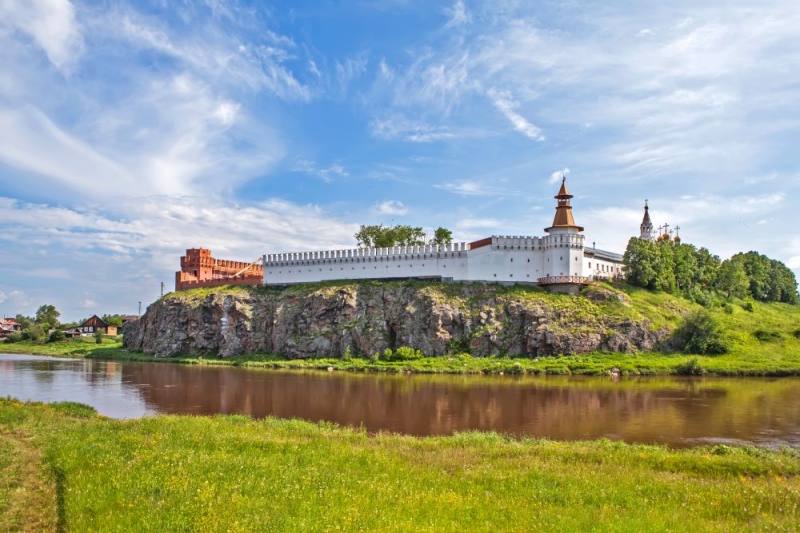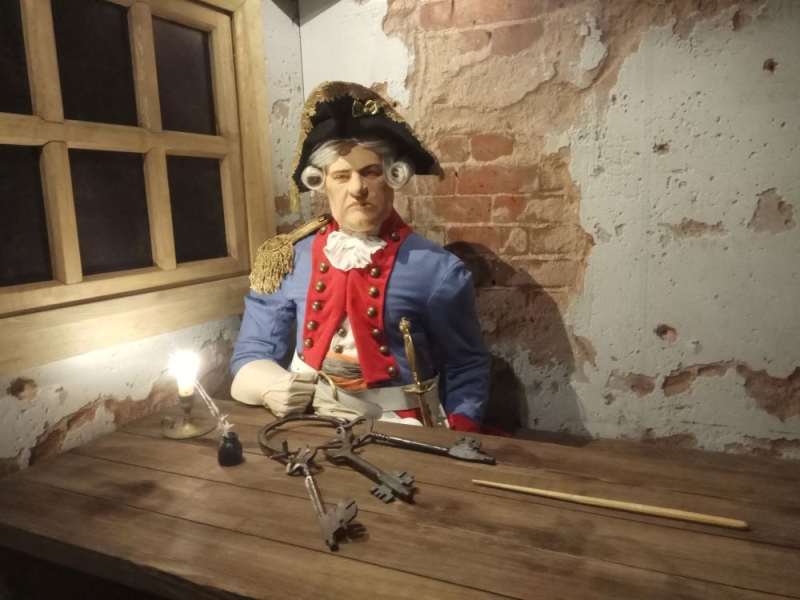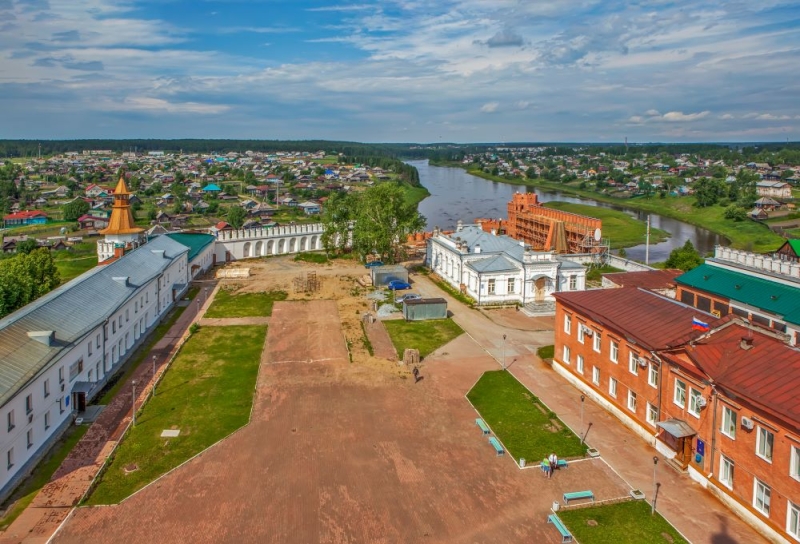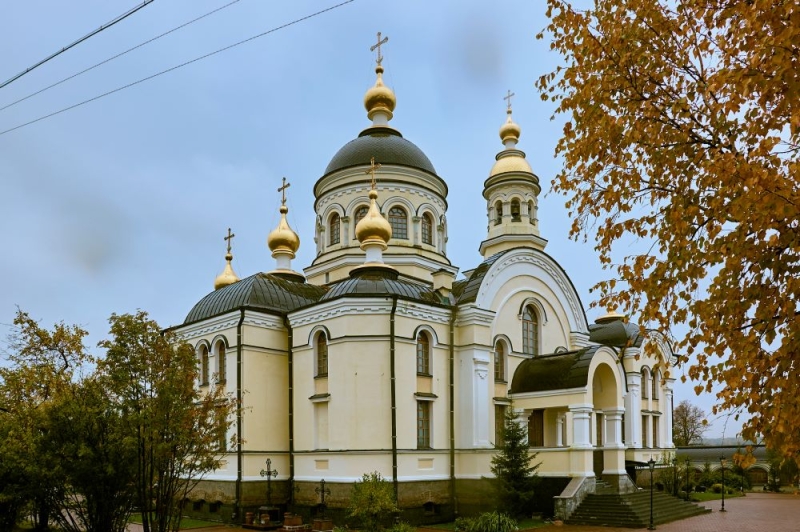
Verkhoturye is a small Ural town with a population of just over 8,000 people. This is a place with a rich history. People come here to visit the smallest Kremlin in Russia, which is also the only one in the Urals, and to admire the ancient domes and church domes – the first Ural monasteries have been preserved in the city.
Verkhoturye is called the Ural Suzdal and the spiritual center of the Urals – there is something to see here for lovers of architecture and antiquity, and for pilgrims who come from afar to venerate the relics of St. Simeon of Verkhoturye. The founding of the city in 1598 is associated with the development of the Urals and Siberia. The new fortress was erected on the newly opened Babinovskaya road – a short route from Solikamsk to Siberia. The fortress built on the site of the Vogul town of Neromkur was called the “gateway to Siberia” and a customs house was installed through which all the riches of the new lands were transported.
How to get there

Station
By plane in combination with a car, bus or train. From Moscow to Yekaterinburg, fly in 2 hours 20 minutes, the cost of a round-trip ticket starts from 3,500 rubles*.   ;
Upon arrival you need to change transport. By car you will cover a distance of 301 km in 4 hours – rent will cost you 4,000 rubles per day*. “Swallow” will deliver you in 4 hours 20 minutes and 564 rubles. A bus from the North Station will cost 940 rubles one way, travel time is 5 hours.
Where to stay
Monasteries provide shelter for pilgrims – for example, in St. Nicholas you can stay for three days for free. There are several hotels for tourists.
What to see
Verkhoturye has a very compact historical center – right opposite the Kremlin there is the St. Nicholas Monastery, and you can walk to the Intercession Convent in ten minutes, looking at the pre-revolutionary buildings.
Kremlin

The city began with a wooden fortress, which often burned and required “renewal”. In 1699, by decree of Peter I, the construction of the only stone Kremlin in the Urals began. A fortress with an area of 2 hectares completed in 1712.
The best view of the smallest Kremlin in Russia opens from the suspended pedestrian bridge over the Tura River – this is a favorite place for tourists and professional photographers. The descent to the river is reminiscent of the Sofia Vzvoz in the Tobolsk Kremlin, which also has the status of the only one, but in Siberia.
Verkhoturye Historical and Architectural Museum-Reservecreated in 1999, it includes the Kremlin, the Holy Trinity Cathedral, the Voivode’s House, the Order Chambers, the Sovereign’s Barns and the District Treasury. Unfortunately, some of the administrative buildings on the territory of the Kremlin were rebuilt in the 19th century, including the Voivode’s House and the Executive Chambers.
On a tour of the Kremlin, you will be told about the first inhabitants of the city and the heyday of Verkhoturye, which was associated with the appearance of customs in the city, and will also be shown the eastern walls preserved from the beginning of the 18th century with loopholes for archers. Entrance to the Kremlin territory is free, a tour for a group of up to 10 people costs 600 rubles.
Interiors of the customs house, a model of the wooden Kremlin, the interactive Babinovskaya road and household items of the Verkhoturye people of the 17th – early 20th centuries. shown in the museum located in the building of the former Sovereign barns.
I invite the bravest guests to visit Prison prison – a basement room in the 18th century Cookhouse-Guard building. At various times, the fort’s guests included the rebellious Voguls, Archpriest Avvakum, and the uncles of the first Russian Tsar from the Romanov family. Museum employees say that, despite his status as an exile, the fiery archpriest was received in the city very solemnly. Women’s cries are heard here, and mice live in cells with tattered convicts – the exhibition is not for the faint of heart.

Prison prison
Photo: Maria Vikhreva
Inspection of each exhibition costs 100 rubles per person, permission for non-professional photography costs 50 rubles*.
The most interesting, in my opinion, preserved object of the Kremlin is Trinity Cathedral. It was founded by decree of Peter I in the same year as the founding of St. Petersburg, and already in 1709 the snow-white temple was consecrated. Experts believe that this is the best example of Moscow Baroque in the Urals, and tourists admire the decorative elements of the cathedral – the patterned masonry of platbands and cornices, green tiles and elements of the octagonal windows on the south side of the cathedral that harmonize with them in color. In Soviet times, there was first a club and a blacksmith shop here, then a library. At the end of the last century, the Trinity Cathedral was planned to be included in the list of UNESCO World Heritage Sites, but this has not yet happened.

The breath of history can be felt in the stone bulk of the cathedral. It seems that behind its walls is the beginning of the 18th century, still wild Siberia, and archers are serving on the fortress walls.
Be sure to climb the tented bell tower, to do this in the church shop in the chapel of St. Martyr Kharlampy ask for the key (donation 50 rubles per person*). The spiral staircase is very narrow – if you are afraid of closed spaces, it can be uncomfortable. From the top there is a beautiful view of the domes of the cathedral, the Kremlin courtyard and the panorama of the St. Nicholas Monastery.

Photo: Sergei Afanasev/Shutterstock.com
In the church shop, buy a tourist map of Verkhoturye – local historians participated in its development. It will come in handy when walking around the city.
Near the Kremlin located St. Nicholas Monastery. It was founded almost simultaneously with the city, in 1604, but became widely known only a century later, after the discovery of the relics of St. Simeon of Verkhoturye. The monastery was a center of attraction for pilgrims not only from the Urals and Siberia, but throughout Russia. Grigory Rasputin loved to come here and Nicholas II even planned to come here, but the First World War began and the trip was canceled.

On the territory of the monastery you can book an excursion, visit the Orthodox Museum in the Igumensky building (currently under reconstruction) or take a walk on your own. B in the refectory you can have a tasty and inexpensive lunch, I especially recommend dumplings with fish.
The Church of the Transfiguration of the Lord (1834) and the Transfiguration Cathedral (1821-1836) have survived to this day. But the greatest interest is Cathedral of the Exaltation of the Cross, built for the tercentenary of the Romanov dynasty. The third largest after St. Isaac’s and the Savior on Spilled Blood, it was consecrated in 1913, but only the altar was painted. After the revolution, a colony for juvenile delinquents was located here. The restoration of the monastery began in 1990 and is not yet completed. In the cathedral, pay attention to the unique faience iconostases with doves and the canopy over the shrine with the relics of Simeon of Verkhoturye, a revered local saint.

From the monastery, take a walk to Pokrovsky Convent. It was founded in 1621 and is known as a place of exile for royal brides – for example, Maria Khlopova, the bride of Mikhail Fedorovich, stayed here. The monastery instructed pagans from among the indigenous inhabitants in the faith, and also accepted schismatics and “penance wives”—women serving sentences—for repentance.
Now being restored New Intercession Church, consecrated in 1902 and turned in Soviet times to the bathhouse. Near the temple, the nuns keep animals exotic for the Urals – alpacas, which invariably cause delight among children and adults. Tourists are especially pleased with the baby dressed in a blanket.

Photo: Maria Vikhreva
The monastery also has its own dairy farm, so don’t forget to buy the monastery’s own cheese. There are hard cheeses made from cow’s milk and soft cheeses from goat’s milk. My friends and I took emmental, parmesan and soft goat – I strongly recommend it.
The rest of the day can be spent walking along the pre-revolutionary streets or going to the village of Merkushino 50 km from Verkhoturye. This is the birthplace of the “miracle worker of all Siberia,” Saint Simeon of Verkhoturye. The temple complex with the Archangel Michael Cathedral and the Simeon Church was destroyed in the last century and restored today. Along the way, stop at Simeon Hill to admire the Church of All Saints, built in the style of Russian wooden architecture. If you go by car, be careful – in some places the asphalt turns into a broken dirt road.

Photo: Karachev Yuriy/Shutterstock.com
I recommend eating in Verkhoturye – the refectory and tea room in the monastery are open from 9 a.m. to 5 p.m. Later you can refresh yourself at the Solyanka cafe — you’ll have to wait about twenty minutes for your order, but the food is delicious.
*Prices valid at time of publication

